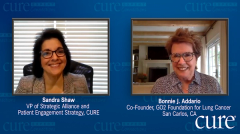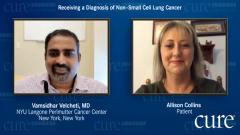
Advocacy and Education for Biomarker Testing in Non-Small Cell Lung Cancer
Ms. Addario shares the promising hope for patients with lung cancer and describes the steps in the process of biomarker testing for patients with lung cancer.
Episodes in this series

Sandra Shaw: I was just thinking about your book that’s coming out. It has over 20 patients’ stories, and no two patients’ stories in that book are alike. For every single patient with lung cancer, their journey is completely different.
Bonnie Addario: Exactly.
Sandra Shaw: At this point, let’s talk about what it looks like for a patient to have biomarker testing in non-small cell lung cancer. Can you walk us through the first steps in the process for biomarker testing, let’s say, from diagnosis and biopsy to requesting that next-generation sequencing? What is the patient’s job in the process?
Bonnie Addario: The best thing a patient can do when they’re diagnosed, if they feel they’re not getting all the information they need—more often than not in the community, that could be the case—is to find a foundation like ours. There are other ones out there that are just as wonderful. They have patient hotlines you can call and get all that information about biomarker testing, about just what I just said, tissue vs blood. We’ve got all the answers they need, and they absolutely need to do that.
I can’t remember a patient who came to us—and this happens with other foundations too; we’re not the only ones that have these services—and said, “I had no idea. My doctor never said anything to me about these things. Where do I go for this?” We’ve got people who help them with payment, help them through the entire—I almost said journey, but patients don’t like this to be called a journey. They say journey is a holiday or a vacation. This is not a holiday or a vacation. Let’s call it their experience. We have a program called the “living room,” and once a month we have a key opinion leader come in and talk. We have it virtually now, but normally we have patients in the room—you’ve been there, Sandra. We have somebody from every possible thing you need to talk to somebody about lung cancer. We have Roy Herps coming in. He’s going to be our speaker. It will be a virtual event. So that’s another area where patients can get all the information they need. Patient handbooks, help with finances, where to go—they’re so lost, they don’t even know that a lot of pharmaceutical companies have help for patients who can’t pay, for the underserved and those folks. There’s a solution out there for everyone in some form or fashion.
Sandra Shaw: Thanks for providing all that hope to patients. It is an experience, not a journey. We know that not everyone gets on the right path, gets the right testing. But what happens if a patient is armed with this information and their physician says you don’t need the test?
Bonnie Addario: Then we and others offer the same thing to give them a second opinion and get them in to see somebody who we know is going to give them all the information they need to get through their lung cancer experience, with all the potential new things that they need.
Sandra Shaw: Thanks for that. Second opinions are an important thing for patients to be aware of. What happens once they do get that test? They’ve had their diagnosis. They’ve had the biopsy. They do get the test, and they’re waiting for results. Some patients start treatment. Other patients may just be waiting for results. What should the patient be doing during that time?
Bonnie Addario: They should be doing everything possible. We have a patient handbook that goes through everything from clinical trials to biomarker testing. Others have things like that as well. They should be getting as much information as possible about their lung cancer. Ask questions, read, learn, ask your doctor questions, and ask your doctor for a second opinion. Anybody worth his or her salt is going to say, “Let me give you some names.” The physician isn’t going to be mad at you. Too often patients think, “I don’t want to tell my doctor that I don’t believe in him.” This is your life. It’s OK for you to get a second opinion, and they know that too.
Sandra Shaw: It’s empowering for them to be able to advocate for their own health.
Bonnie Addario: As a rule, not many clinics and community hospitals participate in clinical trials. But something new that’s starting to evolve is they’re doing pieces of clinical trials. We need to bring care to the patient, not make the patient come to the care. Especially in clinical trials where the community hospital can do all the testing, the blood work, the screen and the scans that the patient needs to stay in the clinical trial. They maybe have to fly once every three months or so to go to the facility that is running that trial. That makes it a lot easier.
People don’t understand that more often than not, when somebody has cancer or a life-threatening disease, they still have to work. They don’t just get to say, “I have cancer. I get to stay home and lie on the sofa.” That’s not the way this works. We have to do everything we can to make them as comfortable as possible.
The failure rate for clinical trials is about 4%—that’s unsatisfactory. That’s completely unsatisfactory, but the biggest reason is accrual. These patients say, “I live in Denver. I can’t fly to New York twice a month to be on this clinical trial—that’s insane.” If we worked on accrual as well—targeted markers, profiling—we have so many tools in the box. When I was diagnosed 17 years ago, you know what the choice was? The choice was chemotherapy and radiation. I was lucky enough to have a surgeon who said, “Bonnie, we’re going to see what we can do, to see if we can’t keep you alive a little longer.” Here I am 17 years later. Second opinion? He was my third opinion.
Transcript edited for clarity.







